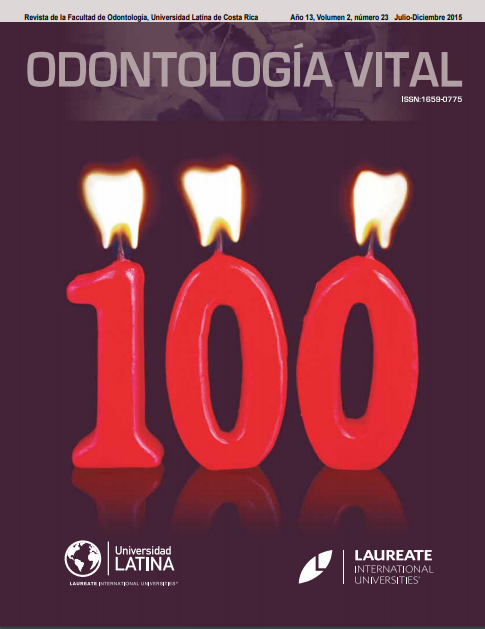Factores de riesgo de caries en embarazadas beneficiarias de Centros de Atención Primaria la Comuna de Quillota y Calera, Chile: estudio transversal
DOI:
https://doi.org/10.59334/ROV.v2i23.267Palabras clave:
Caries, embarazo, mutans streptococci, lactobacilliResumen
La alta prevalencia de caries en embarazadas y el estudio de sus factores de riesgo son de importancia en el ámbito de la salud pública. El objetivo de este estudio es identificar factores que podrían estar asociados a una mayor prevalencia de caries en embarazadas, beneficiarias de Centros de Atención Primaria de la comuna de Quillota y Calera.
Métodos: Estudio transversal analítico, en 217 embarazadas, que evaluó factores sociodemográficos y de salud general, mediante un cuestionario autoaplicado, experiencia de caries, con índice cariados, obturados y perdidos (COPD); índice de higiene oral, presencia de streptococcus mutans y lactobacilos en saliva, capacidad buffer de la saliva y frecuencia de consumo de alimentos. El estudio fue aprobado por el Comité de Bioética de la Facultad de Medicina de la Universidad de Chile y cuenta con consentimiento informado para los participantes.
Resultados: de las 217 pacientes el 55% presentó caries, con índice COPD de 8,60 IC95% [7,32:8,89]. Los factores de riesgo que presentaron diferencias significativas para la media de COPD fueron la edad, condición de multípara, baja capacidad buffer de la saliva, madres sin trabajo remunerado y que habían perdido dientes el último año (p<0,05).
Conclusiones: Este análisis muestra una alta prevalencia de caries en el grupo de embarazadas, asociado a factores socioeconómicos (como el trabajo remunerado de la madre) y biológicos como la capacidad buffer de la saliva.
Descargas
Referencias
Análisis de situación de salud bucal 2012, MMINSAL
Berkowitz, R.J., (2006) Mutans streptococci: acquisition and transmission. Pediatr Dent. 28(2): p. 106-9; discussion 192-8.
Bogges K.A., B.L., (2006) Oral Health in women during preconception and pregnancy: Implications for Birth Outcomes and infant oral health. Matern Child Health J. 10: p. S169-S174. https://doi.org/10.1007/s10995-006-0095-x
Burt, B. A. (2002). “Fluoridation and social equity.” J Public Health Dent 62(4): 195-200. https://doi.org/10.1111/j.1752-7325.2002.tb03445.x
Caufield, P.W., G.R. (1993) Cutter, and A.P. Dasanayake, Initial acquisition of mutans streptococci by infants: evidence for a discrete window of infectivity. J Dent Res. 72(1): p. 37-45. https://doi.org/10.1177/00220345930720010501
Laine, M. A. (2002). “Effect of pregnancy on periodontal and dental health.” Acta Odontol Scand 60(5): 257-264. https://doi.org/10.1080/00016350260248210
Lim, S., W. Sohn, et al. (2008). “Cariogenicity of soft drinks, milk and fruit juice in low-income african-american children: a longitudinal study.” J Am Dent Assoc 139(7): 959-967; quiz 995. https://doi.org/10.14219/jada.archive.2008.0283
Marsh, P.D., (1994) Microbial ecology of dental plaque and its significance in health and disease. Adv Dent Res, 8(2): p. 263-71. https://doi.org/10.1177/08959374940080022001
Moncada G., I. U., Ed. (2008). Cariología clínica Bases preventivas y Restauradoras Capitulo 3. Factores de riesgo de la actividad cariogénica en la dinámica clínica del proceso de caries. Santi ago
Nyvad, B., et al., (2013) Dental caries from a molecular microbiological perspective. Caries Res. 47(2): p. 89-102. https://doi.org/10.1159/000345367
Perez A., B.M., Espeso N., Miranda M., Gonzalez B., (2011) Caries dental asociado a factores de riesgo durante el embarazo. Rev. Cubana de Estomatología, 48(2): p. 104-112.
Petersen, P. E. (2003). “The World Oral Health Report 2003: continuous improvement of oral health in the 21st century--the approach of the WHO Global Oral Health Programme.” Community Dent Oral Epidemiol 31 Suppl 1: 3-23. https://doi.org/10.1046/j..2003.com122.x
Ribeiro, N.M. and M.A. Ribeiro, (2004) [Breastfeeding and early childhood caries: a critical review]. J Pediatr (Rio J). 80(5 Suppl): p. S199-210. https://doi.org/10.1590/S0021-75572004000700012
Silk, H., et al., (2008) Oral health during pregnancy. Am Fam Physician, 77(8): p. 1139-44.
Takahashi, N. and B. Nyvad, (2008) Caries ecology revisited: microbial dynamics and the caries process. Caries Res,. 42(6): p. 409-18. https://doi.org/10.1159/000159604
Takahashi, N. and B. Nyvad (2011). “The role of bacteria in the caries process: ecological perspectives.” J Dent Res 90(3): 294-303. https://doi.org/10.1177/0022034510379602
Takahashi, N. and B. Nyvad, (2011) The role of bacteria in the caries process: ecological perspectives. J Dent Res. 90(3): p. 294-303. https://doi.org/10.1177/0022034510379602
Vergnes, J.N., et al., (2012) Frequency and risk indicators of tooth decay among pregnant women in France: a cross-sectional analysis. PLoS One,.7(5): p. e33296. https://doi.org/10.1371/journal.pone.0033296
Villagrán, E., A. Linossier, et al. (1999). “[Co unt of salivary Streptococci mutans in pregnant women of the metropolitan region of Chile: cross-sectional study].” Rev Med Chil 127(2): 165-170. https://doi.org/10.4067/S0034-98871999001200007
Descargas
Publicado
Número
Sección
Licencia
Derechos de autor 2015 Vezna Sabando Franulic

Esta obra está bajo una licencia internacional Creative Commons Atribución 4.0.
Los autores que publican con Odontologia Vital aceptan los siguientes términos:
- Los autores conservan los derechos de autor sobre la obra y otorgan a la Universidad Latina de Costa Rica el derecho a la primera publicación, con la obra reigstrada bajo la licencia Creative Commons de Atribución/Reconocimiento 4.0 Internacional, que permite a terceros utilizar lo publicado siempre que mencionen la autoría del trabajo y a la primera publicación en esta revista.
- Los autores pueden llegar a acuerdos contractuales adicionales por separado para la distribución no exclusiva de la versión publicada del trabajo de Odontología Vital (por ejemplo, publicarlo en un repositorio institucional o publicarlo en un libro), con un reconocimiento de su publicación inicial en Odontología Vital.
- Se permite y recomienda a los autores/as a compartir su trabajo en línea (por ejemplo: en repositorios institucionales o páginas web personales) antes y durante el proceso de envío del manuscrito, ya que puede conducir a intercambios productivos, a una mayor y más rápida citación del trabajo publicado.








